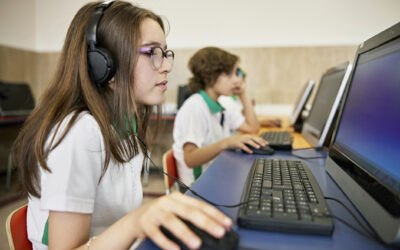Computational thinking has become important to teaching problem solving in education because it empowers students with processes to develop strategic solutions to complex problems, essentially “leveling up” their skills, or creating algorithms that can make future processes more effective. This enables students to take on more complex challenges and prepare for real-world applications.
Decomposition in Computational Thinking
While the process of computational thinking is multifaceted, there is one key to computational thinking that is essential for success: decomposition. Decomposition is the process of breaking a complex task or problem into smaller, more manageable pieces. From this decomposition, students can eliminate unnecessary information, identify patterns and begin the process of identifying which parts of the problem are most important, how to solve or complete each step, and how those parts can be put together for a clear and unified step-by-step solution.
Why is the Decomposition Technique Required in Computational Thinking?
The technique of decomposition is required in computational thinking because it breaks complex tasks into subtasks while developing a sequentially-based understanding of the problem. This allows unnecessary information to be discarded, patterns to be identified, relevant information to be extracted and the process of step-by-step resolution to be defined for a more effective problem-solving process.
By definition, computational thinking is the process of tackling complex problems and finding a clear, step-by-step solution that can be replicated. Decomposition, therefore, is essential to this process as it includes breaking a task into several sub-tasks, helping to align the task to a step-by-step solution.
Another reason decomposition in computational thinking is important is because it allows each subtask to be examined more closely. This not only helps to categorize information as essential or non-essential, but also empowers the problem-solver with a better ability to analyze each specific part of the task or challenge to more effectively develop a reasonable solution.
Examples of Decomposition in Computational Thinking
Below are some real-world examples of utilizing decomposition in computational thinking:
- You have to clean your house. Instead of facing the task as a whole, you practice decomposition by breaking the task into a to-do list with multiple subtasks.
- To build shelves for a storage space, you practice decomposition by measuring the space, creating a blueprint or plan to determine the size of the shelves and the materials you need to accomplish the task. Next, you purchase the supplies and cut the lumber to size, then install one wall of shelves at a time.
- In science, to prove or disprove a hypothesis, you practice decomposition by creating subtasks including background research, observation, generating a hypothesis, determining which variables to test, performing experiments and drawing a conclusion.
Final Thoughts
Consider how often computational thinking appears in your everyday life. Do you naturally use decomposition and computational thinking to resolve a challenge? For more information about computational thinking and how they apply to students, explore some of our most recent articles:
6 Takeaways from ‘Helping Kids Create a Healthy Relationship with Technology’
Technology has become a powerful tool that fosters creativity and connection among young people, but can also become a source of distress and even abuse. Nearly half of all teens have experienced cyberbullying according to the Pew Research Center, and the majority of...
Computational Thinking Activities for Students
Computational thinking is a problem-solving methodology that combines elements of logic, math and algorithms and applies them systematically to solve problems. Computational thinking includes breaking complex problems down into manageable parts, looking for patterns...
Tips for Creating a Positive Relationship with Technology: Strategies for Adults and Children
Technology has become ubiquitous, impacting nearly every aspect of our lives. While technology offers immense benefits, managing our relationship with digital tools is becoming increasingly important for maintaining mental and physical health. Technology can have...
Boundaries to Support a Positive Relationship with Technology
Healthy technology boundaries are essential to maintaining a balanced relationship with digital devices and the internet. These boundaries help prevent technology overuse, which can lead to issues like sleep disturbances, increased stress and reduced physical...
How Texas Schools Are Integrating the TA-TEKS
Exciting developments are on the horizon for K-8 schools across Texas as they gear up to implement the new Technology Application TEKS (TechApps/TA-TEKS) in the upcoming school year. With a focus on integrating the Tech Apps TEKS into core curriculum areas, schools,...
K-12 Online Safety: Understanding and Mitigating Online Risks for Students
In the digital age, the internet is an integral part of students' lives, offering endless resources for learning, entertainment and social interaction. However, it also presents significant risks that can jeopardize the safety and health of students. As educators,...
Digital Citizenship in Students: Examples and Practice Exercises
Digital citizenship is a crucial concept in today's digital age, particularly for students who are growing up in a world where technology and the internet play integral roles in their daily lives and education. This article explores the concept of digital citizenship,...
Understanding Proclamation 2024 and the TA-TEKS
Understanding Proclamation 2024 and the TA-TEKS In 2024, Texas introduced Proclamation 2024 to begin the process of adopting new instructional materials that would align with the Technology Applications Texas Essential Knowledge and Skills (TA-TEKS) standards that...
Guide to Teaching Algorithms in Computer Programming for K-12 Students
Algorithms are the heart of computer programming, providing the step-by-step instructions that computers follow to perform tasks and solve problems. Understanding algorithms and their implementation in programming is crucial not just for software developers but also...
Planning Digital Literacy Assessment: A Simplified Approach
As educators know, assessments are critical to the learning process. They provide beneficial self-checks to students, informative results to teachers and comprehensive data to administrators. So, when teachers implement digital literacy curriculum, assessments are an...
Technology Skills to Teach Gen Z for Future Success
Gen Z and Gen Alpha will enter a workforce that looks very different than the one their parents and grandparents experienced. Educators know it’s important to consider what skills their students will need to succeed now and in the future, but with the rapid rate that...
Digital Skills for North Carolina Students
In our district, like most others, the use of digital learning tools has catapulted since the pandemic. With students online more than ever, it’s essential that they know how to stay safe on the internet, protect their privacy and understand their digital footprint....

Learning.com Team
Staff Writers
Founded in 1999, Learning.com provides educators with solutions to prepare their students with critical digital skills. Our web-based curriculum for grades K-12 engages students as they learn keyboarding, online safety, applied productivity tools, computational thinking, coding and more.













